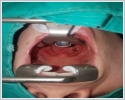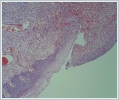|
|||||
AbstractFibroepithelial polyps (FEPs) are benign non-epithelial tumors arising from mesodermal tissue and are commonly seen on the skin and genitourinary system. FEPs are rarely seen in otorhinolaryngology. FEP of tonsil is extremly rare. The etiology is not clear but may involve chronic infection, trauma and allergic factors. Although FEPs are benign, they can be malignant in very rarely cases. We have herein reported a unusual case of a FEP of tonsil symptom presentation with a hemoptysis.IntroductionFibroepithelial polyps (FEPs) are common in the skin and genitourinary system but they are rarely seen in the head and neck region. Only a handful of cases have been reported regarding the relationship of FEPs and tonsillitis. To date, FEPs have been reported in the glottis, piriform fossa, oropharynx, tongue, lower concha, external auditory canal, middle ear beside in the tonsil and in the head and neck area [1-5]. Despite unknown etiology of polyps, chronic infections and mucosal traumas are thought to play a role in polyp formation. Fibroepithelial polyps of the tonsil may vary widely in size and symptom. They may cause complaints such as sensation of choking at intervals, foreign body sensation in the back of the throat, cough and hemoptysis. Polyps can also cause anemia due to chronic bleeding [6]. Case ReportA 33-year-old female came to the otorhinolaryngology clinic of Çorlu Reyap Private Hospital with a history of bloody saliva for the past one month. She had also suffered frequently from recurrent tonsillitis. There was no history of breathing difficulty and change in voice. He had no comorbidities and was not taking medication. She was 10 packs/year smoking history, but did not consume alcohol. There was no history of allergies and trauma. On physical inspection, oropharyngeal examination 1.3x0.4 cm polypoidal mass observed a finger-like pedunculated arising from the middle pole of the right palatine tonsil.(Figure 1).
The patient underwent removal of the lesion by cold steel dissection bilateral tonsillectomy under general anaesthesia. The right palatine tonsil with the lesion was sent for histopathological evaluation that revealed an fibroepithelial polyp (Figure 2).
Fibroepithelial polyps of tonsil have been reported in the literature, as shown in Table.1 Table.1 No.of Cases Author (Ref.) Age (y)/ Gender Size(mm) Presenting symptoms Treatment
Y=Years; M=male; F=female Size: length × transverse diameter DiscussionFibroepithelial polyp (FEP) is a benign lesion of mesodermal origin and is one of the most common skin and genitourinary systemlesions. Prevelance of FEPs is approximately 12 per 1000 population. In this patients, a male predominance[10].[ ]FEPs of tonsil are extremly rare entity in otorhinolaryngology. Although malignancy is rare, excision biopsy is always advisable [11]. To our knowledge, this case represents the eighth tonsil fibroepithelial polyp case in the English language report. The pathogenesis of the FEPs are unknown. However, they have been linked with a few theory. Several theories regarding the etiology of these polyps have been postulated. One of these theories suggests with chronic inflammation to linked. Particularly in chronic infections, tissue obstruction may occur and then irreversible obstruction in the lymphatic ducts [12]. In our case there was a history of chronic tonsillitis. Another theory in the formation of polyp is that it occurs after mucosal trauma. Mucosal trauma can also increase the vascularity of the tissue, leading to obstruction of the lymphatic ducts. In our case, there was no history of trauma to the tonsillar region. To our knowledge, the present study is the first described case of the FEPs symptom show with hemoptisis of the tonsil. Symptoms are usually mild and nonspecific. Our case stated that there was a blood complaint in saliva that had been ongoing for the past one month. However, anemia has been reported in one case due to chronic bleeding [13]. FEPs needs total excision because of the possibility of extremely low incidence of tissue metaplasia [11]. The exact diagnosis should be made according to the pathological examination of the excised tissue. FEPs of the tonsil are rarely symptomatic. When symptoms appear may vary depending on the size of the origin. Rarely, polyps can close the laryngeal area, causing death airway problems [3]. FEPS may cause suffocation by occluding the oral cavity. The largest tonsil FEP reported to date is 7.5 cm in size [9].[ ]In our case, the size of the FEP is 1.3x0.4 cm in size. Traditionally, unilateral placement has been reported in tonsillar polyps cases to date [1,6,7,8] In our case, it was unilaterally located. Bilateral polyp has been reported in one case to date.[9 ]The tonsil should be examined in detail in throat examination. Bulky and color-changing masses from the tonsil surface should be evaluated for differential diagnosis. In tonsillar FEPs, hamartoma, lymphangioma, lymphangiomatous polyp, fibroma, juvenile angiofibroma, squamous papilloma can be considered in its differential diagnosis [1]. Conclusion In conclusion, our case highlights several key points. First, fibroepithelial polyps and other benign tonsillar lesions are very rare. When they do arise, these patients should be asked preoperatively for chronic tonsillitis. Therefore, tonsillar fibroepithelial polyps is achieved by tonsillectomy. Second, hemoptysis can be a first sign of fibroepithelial polyps of the tonsils. Unlike other reported cases, hemoptysis was the presenting complaint in our case. Third, in these patients the risk of malignant transformation of tonsil lesions should be kept in mind and FEPs should be managed by complete excision. References
|
|||||
| Keywords : fibroepitelyal polip , hemoptizi , tonsilla palatina , benign tümör | |||||
|





